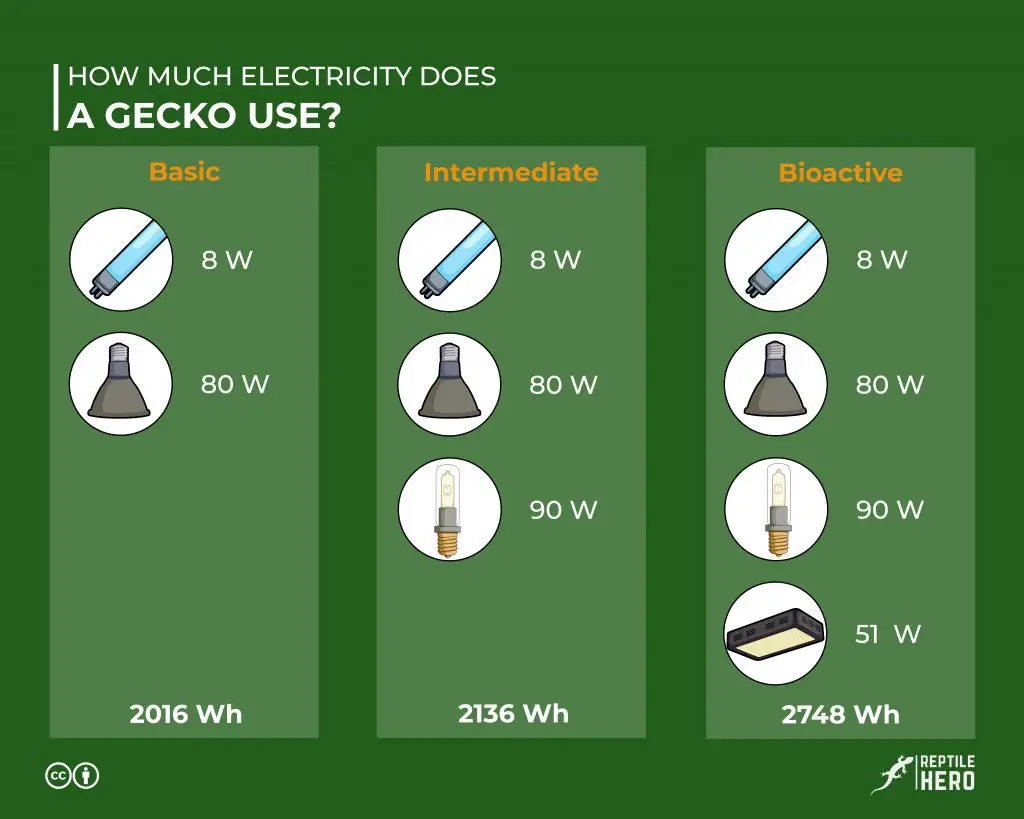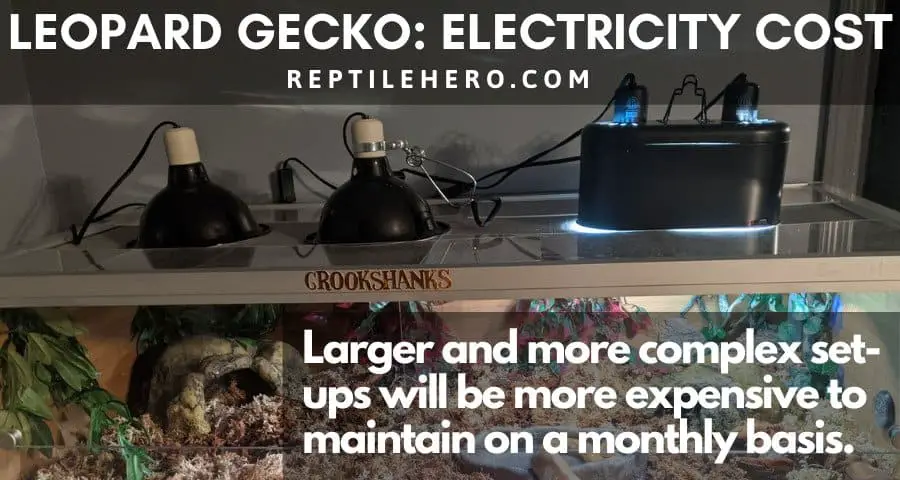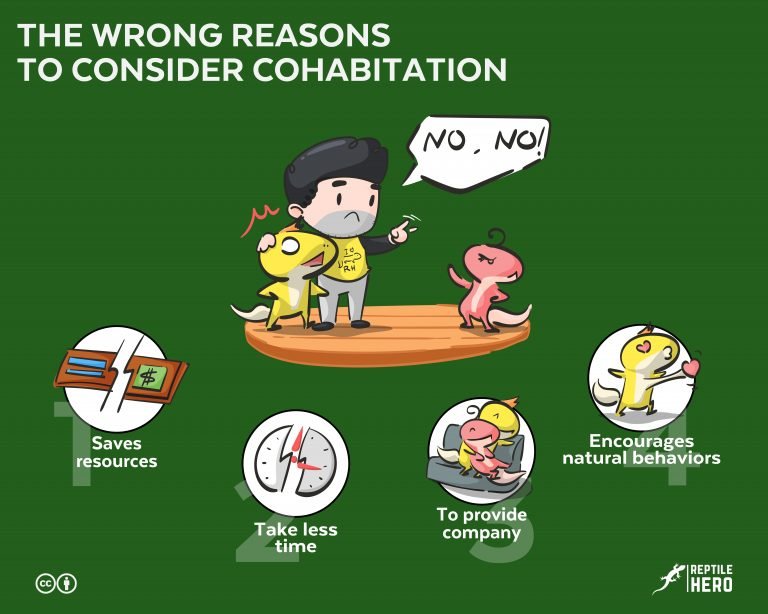How Much Electricity Does a Gecko Use? [Full Bill Breakdown]
Still having trouble trying to convince your roommate, partner, or parents to let you keep a leopard gecko because of the inevitable monthly expenses for electricity? Fret not – keeping a gecko while providing ample heating and a normal day-night cycle is much cheaper than most other people actually think!
On average, keeping a single adult leopard gecko in a 40 or 50-gallon tank would consume approximately 60-80kWh per month. Lighting and heating are the two main factors that comprise a gecko’s electrical energy consumption. A gecko owner’s monthly bill would roughly be 10-30 USD, depending on local electricity rates.
Ready your calculator as I tell you all about your gecko’s electricity consumption!
How to Calculate Your Gecko’s Electricity Consumption
Before we get right into listing your gecko’s electrical devices and estimating how much you would need to spend for its monthly electricity, let’s have a quick physics class review! Now, don’t panic just yet – I promise you, this won’t be anything complicated.
Electrical Power and Electrical Energy Consumption
Electrical power is the first key factor in assessing how much you will pay on your bills. One device that has a double power of another will cost you double on your bills (if ON for the same amount of time). This is expressed in Watts (W).
You can easily identify a device’s power rating on its packaging, or the product itself because manufacturers do often declare such information. A reptile heating mat like this one on Amazon, for example, has a power or wattage rating of 16W.
Is 16W too much? How much power is a “lot”? Well, to give you an idea of how much is too much below a table of power consumption of normal appliances you have in the house
| Appliance | Power (Approx.) |
| Double Slice Toaster | 750W |
| LCD Screen (21 inches) | 36W |
| 13-inch Laptop | 80W |
Meanwhile, electrical energy consumption is the total amount of electrical energy a device transfers or uses over a certain period of time. This is expressed in Watt-hours (Wh) or kilowatt-hours (kWh).
The equation is for energy consumption is simple:
Electrical energy consumption = electrical power multiplied by total hours of operation.
Essentially: the longer an electrical device is on, the more energy is consumed for its operation, and the higher your electricity bill will be.
Here’s a short but straightforward video on energy use in electrical appliances:
Example of energy calculation!
To illustrate this further, let’s take a 60W ceramic heat emitter (CHE) like this one from Amazon into consideration. If you only turn on a 60W CHE for 12 hours during the night, you will only consume 720Wh. For a 30-day month, that will only be 21.6kWh. If you know the price of 1kWh then you just multiply the 21.6kWh for this value and you have the price on your bills. But, of course, that probably isn’t the only thing you provide your gecko with.

In the reptile-keeping community, light and heat elements are the primary electrical devices used for proper husbandry.
There are 8 steps in calculating your gecko’s monthly electricity consumption:
- List down all the electrical devices you use for your gecko.
- Record their respective power rating.
- Note how many hours a day each one is used.
- Create a table for easier computation (4 columns: device, power, time, energy).
- Calculate the daily electrical energy consumption for each device.
- Add up the daily energy for your gecko’s devices.
- Multiply the sum by 30 or the exact number of days for a certain month (e.g. 28, 31).
- Finally, multiple your monthly energy consumption with your area’s electricity rates.
I know this can be difficult to grasp the first time and it can be overwhelming for some, so continue reading below to see the examples we have prepared to help you understand this topic better.
Electricity Consumption and Bill Cost Example For Leopard Gecko

The electricity bill paid to sustain a leopard gecko depends on 1) the devices used in the tank set-up, 2) their power rating, 3) how long they are used, and 4) the local electricity price.
Of course, to make sure we are being realistic here, we need to consider that different keepers prefer to keep their pets in certain tank conditions (this is devices and power rating) that would allow for them to thrive in specific circumstances.
Monthly expenses for electrical energy consumption are not a one-size-fits-all kind of situation. Also, don’t worry! I will avoid getting too technical while explaining this so just keep reading on.
To calculate how much money goes into keeping the average adult leopard gecko warm and active, we need to take into account 3 general types of set-ups:
- Basic – A basic type of set-up is usually quite minimal in terms of lighting and heating. A single light fixture is used to provide a proper day-night cycle (e.g., an 8W UV-B tube light). For all-day heating, a single heat source (e.g., an 80W DHP bulb) may be used in conjunction with a thermostat, to allow for normal night-time drops in temperature.
| Device | Power (W) | Time (Hours in a day) | Energy Consumed (Wh) | ||
| UV-B light | 8 | x | 12 | = | 96 |
| DHP | 80 | x | 24 | = | 1920 |
Intermediate – This type of set-up usually consists of a daytime light source (e.g., an 8W UV-B tube light) and a heat source that is also light-emitting (e.g., a 90W halogen lamp). Then at night, a non-light-emitting heat source (e.g., an 80W DHP bulb) must be provided as well. All heating fixtures must be connected to a thermostat.
| Device | Power (W) | Time (Hours in a day) | Energy Consumed (Wh) | ||
| UV-B light | 8 | x | 12 | = | 96 |
| Halogen lamp | 90 | x | 12 | = | 1080 |
| DHP | 80 | x | 12 | = | 960 |
- Bioactive – Aside from a regular lighting fixture (e.g., an 8W UV-B tube light) and a light-emitting daytime heater (e.g., a 90W halogen lamp), a bioactive set-up will also need full-spectrum lighting (e.g., a 51W LED grow lights) for live plants. For nighttime, a single heating fixture (e.g., an 80W DHP bulb) will normally suffice. To repeat, heaters must be used with a thermostat.
| Device | Power (W) | Time (Hours in a day) | Energy Consumed (Wh) | ||
| LED grow light | 51 | x | 12 | = | 612 |
| UV-B light | 8 | x | 12 | = | 96 |
| Halogen lamp | 90 | x | 12 | = | 1080 |
| DHP | 80 | x | 12 | = | 960 |
Kindly refer to the simple table below to find out how much it would cost to provide lighting and heating for a leopard gecko on a monthly basis in 8 selected areas across the USA, based on the three different set-ups I have discussed briefly earlier on.
| Type of Vivarium Set-up | Basic | Intermediate | Bioactive |
| Monthly Energy Consumption (kWh) | 60.48 | 64.08 | 82.44 |
| x | x | x | |
| New York Electricity Cost (per kWh) | 0.188 | 0.188 | 0.188 |
| = | = | = | |
| Monthly Energy Bill in New York (USD) | 11.37 | 12.05 | 12.05 |
Below you can find the electricity price for each city we used in this analysis [1]. If you live nearby them then it is very likely your electricity rates will be similar.
| US Area | Electricity Price (USD per kWh) |
| New York | 0.188 |
| Chicago | 0.148 |
| Miami | 0.117 |
| Dallas | 0.128 |
| Denver | 0.137 |
| San Diego | 0.347 |
| Alaska | 0.201 |
| Hawaii | 0.295 |
To get a more accurate estimation for different areas across the US, please refer to the simple table below.
| Type of Vivarium Set-up | Basic | Intermediate | Bioactive |
| Monthly Energy Consumption (kWh) | 60.48 | 64.08 | 82.44 |
| Monthly Energy Costs in New York (USD) | 11.37 | 12.05 | 15.50 |
| Monthly Energy Costs in Chicago (USD) | 8.95 | 9.48 | 12.20 |
| Monthly Energy Costs in Miami (USD) | 7.08 | 7.50 | 9.65 |
| Monthly Energy Costs in Dallas (USD) | 7.74 | 8.20 | 10.55 |
| Monthly Energy Costs in Denver (USD) | 8.29 | 8.78 | 11.29 |
| Monthly Energy Costs in San Diego (USD) | 20.99 | 22.24 | 28.61 |
| Monthly Energy Costs in Alaska (USD) | 12.16 | 12.88 | 16.57 |
| Monthly Energy Costs in Hawaii (USD) | 17.84 | 18.90 | 24.32 |
As you can see, there isn’t much difference in terms of monthly electrical energy costs across different set-ups. In fact, the few-dollar differences are more or less negligible. So if you’re reading this article while you’re still doing your initial research about keeping reptiles such as leopard geckos, consider investing in a bioactive set-up from the get-go.
4 Factors Affecting The Electricity Bill For Geckos Owners
There are 4 important points to take note of regarding the aforementioned examples and calculations:
- Actual rates
- Enclosure size
- Full powerful
- All-day heating
Actual Rates
All rates were based on the average electrical energy prices in selected American metropolitan areas for March 2021, as reported by the US Bureau of Labor Statistics [1].
These are subject to change so check the website or get in touch with your power provider to know the exact rates in your area. Keep in mind that spikes in electricity rates during the winter and summer months are to be expected.
Enclosure Size

Hero Reptile’s recommended vivarium size of 36 x 18 x 18 in (90 x 45 x 45 cm) was used as the basis for the different types of set-ups and their respective lighting and heating fixtures. Larger tanks may need supplemental lights and heating sources.
Full Power
Figures for monthly energy consumption were determined with all fixtures at full power (wattage or W). So the rates listed above are at maximum power, as using a thermostat for heating elements will affect their operating power and, in turn, total electrical energy consumption.
All-day Heating
Depending on where you live, heating at night may or may not be needed. In areas where it’s cold all year round – below 70°F (21°C) – having a supplemental heat source at night is necessary.
Otherwise, your leopard gecko will do fine with the nightly drop in temperature which mimics what happens in nature. If your leo’s situation is the latter, your expenses will be lower than the examples we have given because I have included nighttime heat elements in my computation.
Takeaways
Electrical power (Watts or W) is the total amount of electrical energy a device needs to work properly while electrical energy consumption (kilowatt-hours or kWh) is the amount of electrical energy a device consumes over time.
In reptile-keeping, lighting and heating elements are the main devices that will need electricity to operate.
The electricity cost of keeping one leopard gecko could be anywhere under 10 or around 30 USD. Expenses will vary depending on a specific keeper’s set-up.
Sources
[1] https://www.bls.gov/regions/midwest/data/averageenergyprices_selectedareas_table.htm


![Is It Possible To Overfeed A Gecko? [4 Signs]](https://www.reptilehero.com/wp-content/uploads/2021/12/overfed-gecko-cc-768x614.jpg)



